«По уральским местам Варлама Шаламова» [Visiting Varlam Shalamov’s Ural ‘Sites’] Posted by josefina on Jul 18, 2009 in History, Soviet Union
The map on the left shows a ‘cluster’ of towns in the Ural Mountains connected with the fate of the great Russian writer and poet «Варлам Тихонович Шаламов» [Varlam Tikhonovich Shalamov], all four of them are located in the northern part of «Пермский край» [Perm Administrative Division (of Russian Federation)]. (The red dot marked with an ‘A’ shows the destination for my next trip tomorrow: «Курган» [Kurgan]). The map on the right shows Shalamov’s four Ural cities almost up-close: «Березники» [Berezniki; red dot], «Соликамск» [Solikamsk; blue dot], «Чердынь» [Cherdyn’; pink dot] and «Красновишерск» [Krasnovishersk; yellow dot]. It takes about six hours by bus to travel from Perm’ to Krasnovishersk.
In December last year (see: “A Great Russian writer: Варлам Шаламов [Varlam Shalamov]”, Dec 7th 2008) I blogged for the first time about the splendid 20th century Russian writer Shalamov here on the Russian Blog. On February 28th 2008 I blogged about my visit to the GULAG museum «Пермь-36» (see: “A Recent Past Remaining in the Present: A Journey to the Former GULAG camp ‘Perm-36′”). Today the time has come to combine three of the most important things mentioned in these two past posts: 1) Varlam Shalamov’s prose; 2) traveling through the big city of Perm’; and 3) Soviet concentration camps. This morning I returned from a little trip up north in the Urals that I decided to give myself as a birthday gift upon turning 24 on the 16th of July – to visit two cities connected with the very difficult and outright tragic fate of Varlam Shalamov. Since he became world famous thank to his terrifying collection of truthful short stories about the horrors of Kolyma – «Колымские рассказы» [“The Kolyma Tales“] – he has become mostly connected with the concentration camps in that part of the USSR. Few people are aware of the fact that Shalamov’s ‘prison experience’ began long before the black year of the purge in 1937, and that he was sentenced for the first time in 1929 for spreading copies of «завещание Ленина» [Lenin’s (Last) Will]. Shalamov was not even 22 years old when he was sent to serve his first term of three years in Soviet concentration camps during the spring of 1929. He arrived first in the city of «Соликамск» [Solikamsk], where he was placed in a transit prison located in the ‘basement of a (former) church’, as he stated in the short story «Первый зуб» [“The First Tooth”] from his short story collection «Артист лопаты» [“The Shovel Artist”]. For a long time it has been generally accepted among scholars and researches of Shalamov’s life and work that this particular ‘church basement’ is to be found in the «Свято-троицкий мужской монастырь» [Holy Trinity Male Monastery], however, lately this fact is becoming more and more uncertain.
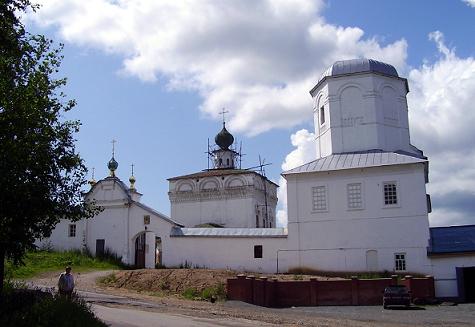
«Свято-троицкий мужской монастырь» [Holy Trinity Male Monastery] in Solikamsk. During the 1920-30’s it served as a prison, and is – possibly – the place where Shalamov spent a night in a cell in the basement of its main building. See the small black square on the white wall? Well, that’s…
…the «памятная доска» [memorial plate] made by the artist «Рудольф Веденеев» and placed on the northern wall of the monastery on the 1st of July 2005. It says: «В марте 1929 года этапом уходил отсюда Варлам Шаламов. Писатель разделил судьбу народа и обители, обращенной в застенок, прошёл тюрьмы и лагеря от Бутырки, Соликамска, Вишеры до Колымы, открыл миру правду ГУЛАГа» [“In March 1929 Varlam Shalamov walked from here under guard. The writer shared the fate of the people and of the monastery that was turned into a prison, (he) went through prisons and camps from Butyrka, Solikamsk, Vishera to Kolyma, revealed the truth about GULAG to the world”].
The first thing I did when I got off the bus from Perm’ in Solikamsk was to go and search for the location of this monastery, as I foolishly thought myself to be one of the first – if not the very first – to have the idea of searching for it according to how it is described in Shalamov’s short story “The First Tooth”. It turned out that not only am I not the first – far from it! – to have come to Solikamsk searching for that very place, I had actually been gravely misinformed about the location of the site of the cell where Shalamov spent that fateful April night in 1929. The second person I met in Solikamsk turned out to be the former director of the museum of Solikamsk, Olga Lebedeva. She showed me first the monastery, then the other possible churches where Shalamov might have spent the night. As she stated: “There are 12 churches in Solikamsk. Pick anyone, state your case and you might be right on the spot!” One scholar in the city says it must have been in the female monastery a bit outside of the city, whereas some think that Shalamov meant the church in the city center. After all, it was dark when he arrived and he wrote the short story around thirty years after the occurance itself. The scholars say that it couldn’t possibly have been in the Holy Trinity Male Monastery because the short story contains a scene where one prisoner breaks a window to let in fresh air, and this saves Shalamov’s life that long night when almost 100 prisoners were stuffed into one little cell. However, the cell in the monastery’s basement has so thick walls that the window glass is too far away and can’t be reached by a human arm from the inside. Also some researches argue that the monastery had not yet been turned into a prison in the spring of 1929. What we do know for sure is that Shalamov spent a couple of days in Solikamsk before heading north – by foot under guard – during five days through the taiga. The same road can now be traveled by bus and takes around two hours. What we also know is that fans of Shalamov like to – just like I did on the 16th of July – visit the monastery anyway, and that they have even written the classic words from the short story on the walls of the cell… twice! Just in case!
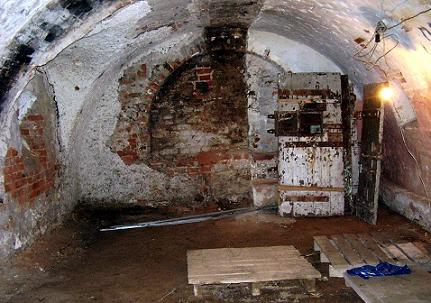
Here is the inside of the monastery’s basement. When it served as a prison this space was turned into two rooms with a wall separating them in the middle. In each of these small spaces almost 100 prisoners were forced to spend the night, unable to lie down or even breathe properly.
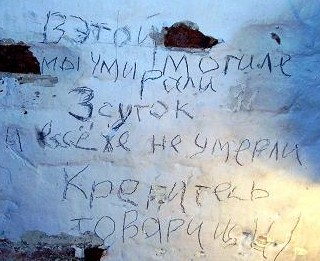
On the room’s ceiling some very dedicated fans of Shalamov have written the famous quote from his short story «Первый зуб» [“The First Tooth”] – not once, but twice, next to each other! – «В этой могиле мы умирали 3 суток, а всё же не умерли. Крепитесь, товарищи!» [“In this grave we were dying for three days, and yet we did not die. Stand firm (alt. hold out; stay strong), comrades!”].
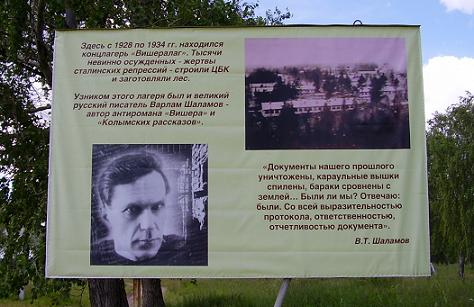
Upon entering the town of «Красновишерск» [Krasnovishersk] you are greeted by this big, new sign – recently erected close to an alley of trees also recently planted in the writer’s honor on the other side of the main road – «Здесь с 1928 по 1934 гг. находился концлагерь «Вишерлаг». Тысячи невинно осуждённых – жертвы сталинских репрессий – строили ЦБК и заготовляли лес.» [“Here from 1928 till 1934 was located the concentration camp ‘Visherlag’. Thousands of innocent sentenced – the victims of Stalin’s repressions – built the Cellulose Paper Plant and prepared timber”]. «Узником этого лагеря был и великий русский писатель Варлам Шаламова – автора антиромана «Вишера» и «Колымских рассказов».» [“A prisoner of this camp was the great Russian writer Varlam Shalamov – author of the antinovel “Vishera” and “Tales from Kolyma”].
The writing on the poster above continued, followed by my own translation: «Документынашегопрошлогоуничтожены, караульныевышкиспилены, баракисровненысземлёй… Былилимы? Отвечаю: были. Совсейвыразительностьюпротокола, ответственностью, отчётливостьюдокумента» [“The documents of our past have been destroyed, the guard towers sawn down, the barracks evened out with the ground… Were we even here? I answer: we were. With all the expressiveness of a protocol, with the responsibility, the clarity of a document”].
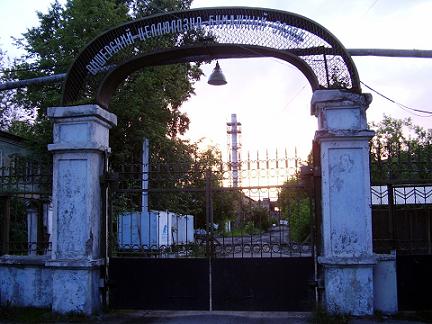
The entrance to the factory built by the concentration camp’s workers: «Вишерский целлюлозно-бумажный завод» [Vishersky Cellulose Paper Factory]. Today the factory that once employed several thousand people lay in ruins on the shores of the river «Вишера» [Vishera].
It has been proved that Shalamov spent no less than ten months working in the concentration camp located on the river «Вишера» [Vishera] between his arrival in April 1929 and his release in October 1931. The memory of Shalamov is treated with much respect in the town of Krasnovishersk; the town itself asked to have the year 2007 be made the year of Varlam Shalamov in it. During that year they erected three monuments in his honor; already in 2002 a monument to the prisoners building the paper plant between 1929 and 1934 had been erected outside of the factory. I arrived in Krasnovishersk with a few addresses scribbled on a piece of paper – the location of the various monuments as stated on the splendid official Russian site dedicated to Shalamov, together with the name of what should be a hotel. The hotel turned out to be a hotel and as soon as I had got myself a room, I asked the people there if anyone knew anything about Shalamov. A woman sitting at a table held up her hand and said: “If you’re looking for someone who knows everything about Shalamov and Krasnovishersk, then you’re looking for me!” Her name turned out to be Ludmila Sokolova; she is the director of the main library in Krasnovishersk and one of the main people behind the celebration of Shalamov in 2007. On Thursday evening she showed me everything in the town having to do with Shalamov, and as she dropped me off at midnight she promised to come pick me up next morning. Said and done, next morning she was waiting for me after breakfast and we went to visit the local museum. After that we went to the library where she presented me with all of the documents and books and articles available in their archive. She helped me make copies of everything I wanted and needed, then she gave me the book «Красное колесо Вишеры» [“The Red Wheel of Vishera”]. She was most kind, helpful and attentive to me and my needs, it was actually very surprising and touching. When we left the library to have lunch together my backpack was filled with all sorts of interesting materials about Shalamov and Vishera that I wouldn’t have been able to find anywhere else. I also met with many other people in the town of Krasnovishersk, and each and everyone made deep, pleasant impressions on me. I have never visited a town with a population so careful not to forget its own past, something that is so common in Russia especially nowadays.
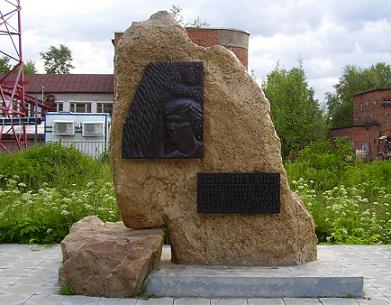
In the center of Krasnovishersk stands a monument made by the same artist who did the monument on the monastery in Solikamsk. It was put up on the 18th of June 2007, on the 100 year anniversary of the birth of the writer. On it we find the following written: «Здесь жили и умирали жертвы репрессий 1920-50 г. В 1929 г. начался лагерный путь Варлама Шаламова. 100-летию писателя. Июнь 2007 г.» [“Here lived and died victims of the repressions (in the) 1920-1950’s. In 1929 began the camp road of Varlam Shalamov. To the writer’s 100th year anniversary. June 2007.”]
Even though there are monuments to Shalamov in both Krasnovishersk and Solikamsk, these were not the only towns in the northern Urals visited by the writer. He also worked in the factory in the town of Berezniki, aswell as in the town of Cherdyn’, and yet there is not so much as a corner named after the writer in those towns. Cherdyn’ is also worth noting as the place of the first exile for the poet «ОсипЭмильевичМандельштам» [Osip Emil’evich Mandelstam’], where he tried to escape but failed. Mandelstam was later transferred to Vladivostok where he died of hunger in 1938. Shalamov wrote a short story about the poet’s death – «Шерри–бренди» – which was published in his “Kolyma Tales”. There is not memorial plate in honor this amazing poet in the town Cherdyn’ – yet. Just like there is nothing reminding of Pasternak in the town of Solikamsk, even though it is known that he visited this town and based one of the towns portrayed in «ДокторЖиваго» [“Doctor Zhivago”] on it. Not all Russian towns where famous writers spent years in hard forced labor camps have done what Krasnovishersk has, but there’s still hope that they might. In the future. Let’s not forget – «надеждаумираетпоследней» [“hope is the last to die”]!
In June 2007 a big wooden cross was also placed on the site where the concentration camp once stood. Nothing else remains to remind future generations of what happened here so that it may never ever be repeated again.
When I left on Wednesday on the night train to Perm’ I didn’t know what awaited me on this journey up north in the Urals. All I knew was that I really wanted to see the place where Shalamov had been – really, I would’ve wanted to go to Kolyma, but that was a little too far away and a little too expensive for me this year. I didn’t know what to expect, so I didn’t expect anything at all. I think that’s the correct way of not only living in Russia, but living in general. After five years in this country I must confess that I am still in love. All of the many hours traveling by bus and train were filled with pure beauty of Russian nature outside my window. You can say whatever you want to say about pollution and global warming – as long as I can see all this beauty for hours and hours I won’t believe any of it. I may be wrong. I think I’m wrong. But in this case I don’t want to be right. I just want to stay in love. With Russia. With Shalamov. With Russian literature. With life. In general. I wish you all the same kind of experiences with nature this summer – not only Russian, of course!

Build vocabulary, practice pronunciation, and more with Transparent Language Online. Available anytime, anywhere, on any device.



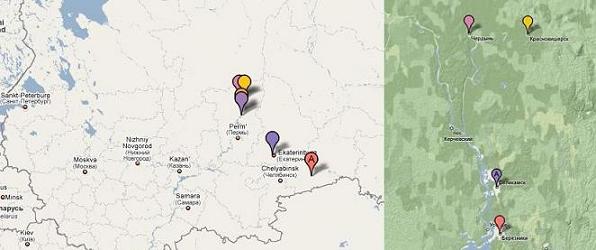
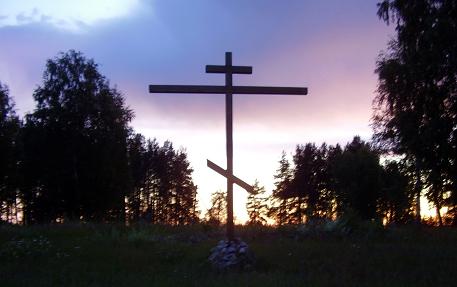

Comments:
Moonyeen Albrecht:
Thank you for this post. I will be visiting the Perm-36 GULAG in August. I keep all your blogs and looked up the Dec. 7,2008 article but want to thank you for putting in the links to previous blogs. That is most helpful! Great job!
Henryk Wistreich, Denmark:
What a beautiful post, sad and heartening at the same time.
ahmad:
Good day, not tired.
Please help me. I am an Iranian teacher. I’m traveling to the city Berezniki next 20 days. Please tell me the best route. How do I travel to the city of Moscow. Thanks